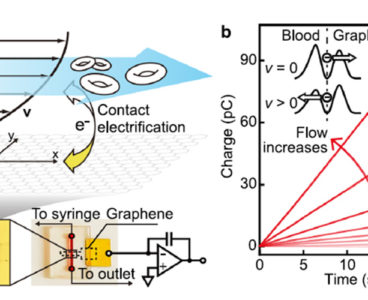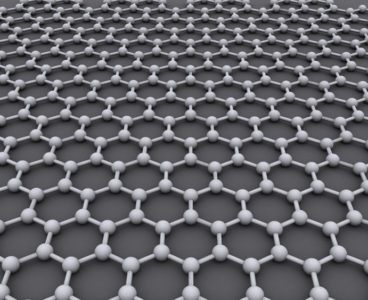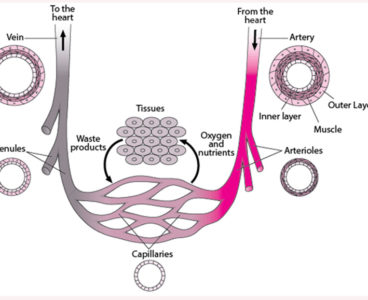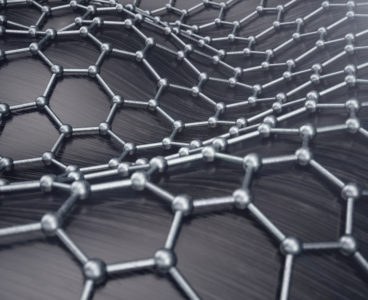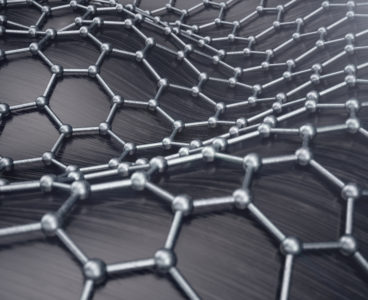by Bill Schweber, Contributing Author The first part of this article looked at the challenges of sensing nano-level flow rates such as found in the blood vessels. In contrast, the second part looked at graphene, an allotrope of elemental carbon at the heart of a new sensor used to measure those flows. This third and…
Graphene-based flowmeter sensor measures nano-rate fluid flows, Part 2: The graphene context
by Bill Schweber, Contributing Author The previous part of this article looked at the challenges of nanoflow sensors, especially with respect to blood flow. This part looks at graphene, which is the basis for the new sensor. Graphene is a material structure which did not exist until relatively recently. However, its constituent element of graphite…
Graphene-based flowmeter sensor measures nano-rate fluid flows, Part 1: The challenge
by Bill Schweber, contributing author When it comes to nearly all biological measurements, the ranges of many of the parameters of interest are orders-of-magnitude below those with which many engineers are familiar. Instead of megahertz or even kilohertz, the living-creature world is in the single or double-digit hertz range, such as the roughly 60+ beats…
A graphene innovation that is music to your ears
Just over 15 years since a couple of researchers in the U.K. used adhesive tape to isolate single atomic layers of carbon, known as graphene, from a chunk of graphite, their Nobel Prize-winning discovery has fueled a revolution in ultrathin materials R&D. Graphene and other atomically thin “2D” materials exhibit exotic properties that researchers hope…
Rice, Tennessee labs shrink laser-induced graphene for flexible electronics
You don’t need a big laser to make laser-induced graphene (LIG). Scientists at Rice University, the University of Tennessee, Knoxville (UT Knoxville) and Oak Ridge National Laboratory (ORNL) are using a very small visible beam to burn the foamy form of carbon into microscopic patterns. The labs of Rice chemist James Tour, which discovered the…
Mathematically Designed Graphene Possesses Superior Electrocatalytic Activity
An international research group has improved graphene’s ability to catalyze the “hydrogen evolution reaction,” which releases hydrogen as a result of passing an electronic current through water. They designed a mathematically predicted graphene electrocatalyst, and confirmed its performance using high resolution electrochemical microscopy and computational modelling. The findings were published in the journal Advanced Science.…
Plumbene, Cousin of Graphene, Created by Researchers
Two-dimensional materials made of Group 14 elements, graphene’s cousins, have attracted enormous interest in recent years because of their unique potential as useful topological insulators. In particular, the up-to-now purely theoretical possibility of a lead-based 2-D honeycomb material, called plumbene, has generated much attention because it has the largest spin-orbit interaction, due to lead’s orbital…
Researchers Develop Wearable Sensor Inspired by Octopus Suckers
Wearable electronics that adhere to skin are an emerging trend in health sensor technology for their ability to monitor a variety of human activities, from heart rate to step count. But finding the best way to stick a device to the body has been a challenge. Now, a team of researchers reports the development of…
New Applications of 2D Materials Enabled by Strain
Superconductors’ never-ending flow of electrical current could provide new options for energy storage and superefficient electrical transmission and generation, to name just a few benefits. But the signature zero electrical resistance of superconductors is reached only below a certain critical temperature, hundreds of degrees Celsius below freezing, and is very expensive to achieve. Physicists from…
Next-gen Core Semiconductor Technology Based on Graphene
The DGIST (Daegu Gyeongbuk Institute of Science and Technology) Department of Information and Communication Engineering has developed a graphene-based high-performance transmission line with an improved operating speed of electrons than using the existing metal in high-frequency. This is expected to contribute greatly to next generation’s high-speed semiconductor and communication device with much faster processing speed…
Graphene Flakes Control Neuron Activity
Chemical Industry Bottleneck Gets a Colorful Solution
The nanoscale water channels that nature has evolved to rapidly shuttle water molecules into and out of cells could inspire new materials to clean up chemical and pharmaceutical production. KAUST researchers have tailored the structure of graphene-oxide layers to mimic the hourglass shape of these biological channels, creating ultrathin membranes to rapidly separate chemical mixtures.…
Graphene and Hydrogen Bind in Just 10 Femtoseconds
Graphene is celebrated as an extraordinary material. It consists of pure carbon, only a single atomic layer thick. Nevertheless, it is extremely stable, strong, and even conductive. For electronics, however, graphene still has crucial disadvantages. It cannot be used as a semiconductor, since it has no bandgap. By sticking hydrogen atoms to graphene such a…
Ink Not Required for Graphene Art Work
When you read about electrifying art, “electrifying” isn’t usually a verb. But an artist working with a Rice University lab is in fact making artwork that can deliver a jolt. The Rice lab of chemist James Tour introduced laser-induced graphene (LIG) to the world in 2014, and now the researchers are making art with the…
Graphene Plasmons Used for Quantum Computing
A novel material that consists of a single sheet of carbon atoms could lead to new designs for optical quantum computers. Physicists from the University of Vienna and the Institute of Photonic Sciences in Barcelona have shown that tailored graphene structures enable single photons to interact with each other. The proposed new architecture for quantum…
Innovative New Nanomaterial Could Replace Mercury
The nano research team led by professors Helge Weman and Bjørn-Ove Fimland at the Norwegian University of Science and Technology’s (NTNU) Department of Electronic Systems has succeeded in creating light-emitting diodes, or LEDs, from a nanomaterial that emits ultraviolet light. It is the first time anyone has created ultraviolet light on a graphene surface. “We’ve…
Custom-made Materials Display Ultrafast Connections
Through magic twist angles and unique energy states, it is possible to design tailor-made, atomically thin materials that could be invaluable for future electronics. Now, researchers at Chalmers University of Technology, Sweden, and Regensburg University in Germany have shed light on the ultrafast dynamics in these novel materials. The results were recently published in the…
Graphene Could Aid Future Terahertz Cameras
A study in Nano Letters reports on the development of a graphene-enabled detector for terahertz light that is faster and more sensitive than existing room-temperature technologies. Detecting terahertz (THz) light is extremely useful for two main reasons. Firstly, THz technology is becoming a key element in applications regarding security (such as airport scanners), wireless data…
‘Deep Learning’ Agents Give Insight into Novel 2D Materials
Scientists are discovering new two-dimensional materials at a rapid pace, but they don’t always immediately know what those materials can do. Researchers at Rice University’s Brown School of Engineering say they can find out fast by feeding basic details of their structures to “deep learning” agents that have the power to map the materials’ properties.…
Researchers Create Artificial Atoms that Work at Room Temperature
Ultra-secure online communications, completely indecipherable if intercepted, are one step closer with the help of a recently published discovery by University of Oregon physicist Ben Alemán. Alemán, a member of the UO’s Center for Optical, Molecular, and Quantum Science, has made artificial atoms that work in ambient conditions. The research, published in the journal Nano…
Graphene Hybrid Energy Method Could Be Utilized by Rockets
Graphene, a new material with applications in biomedical technology, electronics, composites, energy and sensors, may soon help send rockets to space. A new propellant formulation method to use graphene foams—material used in electronics, optics and energy devices—to power spacecraft is being developed in Purdue University’s Maurice J. Zucrow Laboratories, which is the largest academic propulsion…
Predicting the Shape of Squeezed Nanocrystals When Blanketed Under Graphene
In a collaboration between the U.S. Department of Energy’s Ames Laboratory and Northeastern University, scientists have developed a model for predicting the shape of metal nanocrystals or “islands” sandwiched between or below two-dimensional (2D) materials such as graphene. The advance moves 2D quantum materials a step closer to applications in electronics. Ames Laboratory scientist are…
Researchers Explore Record Growth of Graphene Single Crystals
Graphene, especially the graphene single crystal, is a star material for future photonics and electronics due to its unique properties, such as giant intrinsic charge carrier mobility, record thermal conductivity, super stiffness and excellent light transmission. However, whether graphene can live up to the expectation depends on reliable, high-quality synthesis with high efficiency. Recently, one…
Home of Graphene Unveils Revolutionary Graduation Gowns
The University of Manchester graduates of summer 2019 will be the first graduates in the world to wear gowns made entirely from graphene. Following the success of creating the first ever sports shoes to utilize graphene in June 2018, physicists from The University of Manchester have utilized the properties of graphene again to create graduation…
Research Probes Graphene-silicon Devices for Photonics Applications
If you use a smartphone, laptop, or tablet, then you benefit from research in photonics, the study of light. At the University of Delaware, a team led by Tingyi Gu, an assistant professor of electrical and computer engineering, is developing cutting-edge technology for photonics devices that could enable faster communications between devices and thus, the…

